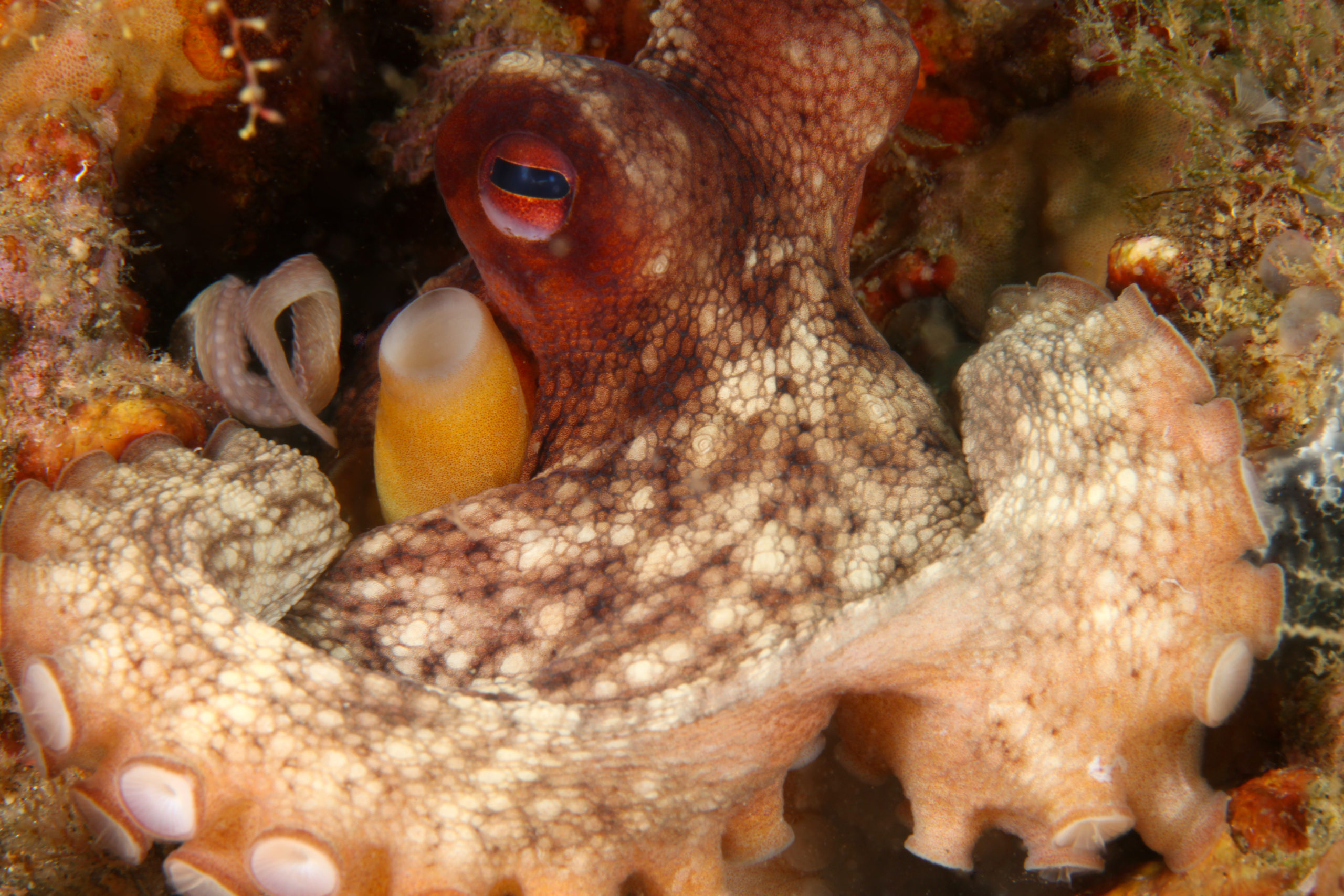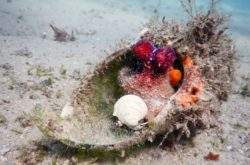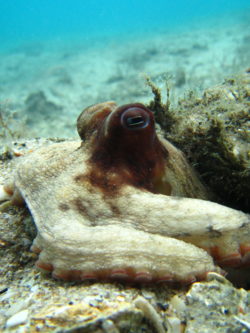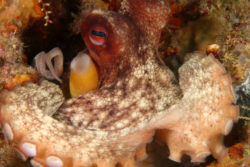
Sea Wonder: Common Octopus

A common octopus hiding in Florida Keys National Marine Sanctuary. Photo: Tiffany Duong
The common octopus (Octopus vulgaris) may be one of the most studied and wide-ranging species of octopus in the ocean, but it is far from being ordinary. It is a skilled hunter, clever hider, master of camouflage, and one of the most intelligent invertebrates of the sea!
Description
The common octopus appears exactly how we would expect – with a bulbous mantle or head, two large eyes, and eight flexible arms. It has pigment cells covering its body and specialized muscles that help to change the animal’s body color and texture to blend in with its surrounding environment. This marine invertebrate can grow to lengths of about 4.3 feet and weigh as much as 22 pounds. It has three hearts, two of which move blood to and from the gills while the third pumps blood to the rest of its body. It is cold blooded, meaning it does not regulate its own body temperature, but matches that of the environment. At the center of its mantle, between its eight arms, is a set of powerful beak-like jaws used to crush its prey.
Diet & Habitat

Common octopus seen in Florida Keys National Marine Sanctuary. Photo: Rachel Plunkett
The common octopus is a skilled nocturnal hunter and one of the most intelligent invertebrates, using objects it finds as tools to help it hide and hunt. They are strict carnivores that typically eat crustaceans like crabs, clams, and shrimp, though it will eat anything it can easily catch. It uses a number of strategies like ambushing, luring prey with objects, and even injecting a venomous saliva into prey to make them easier to catch. Their natural predators can include larger animals like sharks, moray eels, seals, sperm whales, and birds. To defend itself, the common octopus will expel ink to help deter attackers, camouflage to blend into the surrounding environment, compress its boneless body to fit into the smallest cracks and crevices, and expel water jets from its mantle to make for a quick getaway. Sometimes the common octopus will lose one of its arms to a predator, but that’s not a problem as it can fully regrow its arms multiple times throughout its life.
The common octopus is considered a cosmopolitan marine species given its wide range throughout the global ocean. It lives in tropical and temperate waters, and in the National Marine Sanctuary System we often see them in Florida Keys, Flower Garden Banks, and Gray’s Reef national marine sanctuaries. It can live at depths of nearly 600 feet and tends to gather near reefs or where food is abundant. The common octopus is not migratory and is quite territorial but can travel to new areas if it needs to.
Life History
The common octopus is short-lived with a life span of one to three years. After complex mating rituals where males approach females, making dramatic displays with its pigment skills or using objects to win over a mate. They reproduce internally and females lay between 100,000 and 500,000 eggs, all connected in a chain-like fashion; the males die shortly after mating.
Females choose when to lay their eggs based on finding a suitable den site, which they then guard until the eggs hatch and the hatchling larvae grow strong enough to swim, eat, and produce ink. Few common octopus hatchlings survive their first year as they are vulnerable to predation, which is why females lay so many eggs. Those that do make it to adulthood are generally solitary, territorial, and aggressive toward conspecifics that are not potential mates.
Threats & Conservation
The common octopus is well-studied, and populations appear to be healthy and stable. They do not receive special protections under U.S. laws but are listed as “Least Concern” on the International Union for the Conservation of Nature (IUCN) Red List. Although they are not believed to be critically threatened, they are vulnerable to changes like warming oceans, acidification, pollution, habitat degradation, being caught in fishing gear, and prey loss due to overfishing.

The common octopus photographed in Gray’s Reef National Marine Sanctuary. Photo: Greg McFall/NOAA
